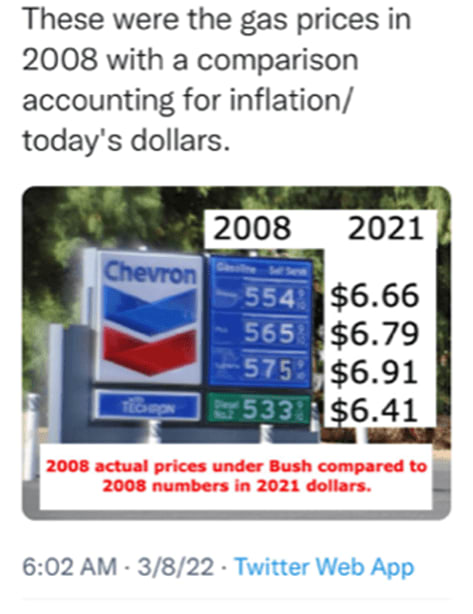Hello, thanks for checking in, I hope this finds you well. There’s endless news about soaring inflation, which is real, but I also want to try and put it into perspective in our everyday lives. So, this week, we’ll look at the differences between inflation and valuation in regard to just about everything but, in particular, to residential real estate.
Impacts of inflation
If you’ve purchased gas or food in the last couple of months and especially in the last week or so, you’ve undoubtedly noticed increased prices. This is the impact of inflation on everyday goods – even though, much to my continued chagrin, energy and food costs aren’t factored into the “consumer price index,” or CPI, that’s used to track our basic costs of living.
The cost of just about everything is going up, from eggs to electronics, and it largely boils down to continued demand outstripping supply, as well as increases to the costs of moving, storing and selling those goods. The pandemic instigated the rapid rises – in part due to the enormous liquidity that resulted from pandemic-related relief programs – and now, as those programs have evaporated, consumers feel the fallout: Higher prices without the safety nets that made them more tenable over the last two years.
As we move forward, it’s important to understand how current inflation impacts real costs and spending and how efforts to curtail it could impact our overall economy.
As we’ve covered
in many previous posts, the Federal Reserve will raise interest rates to try and tamp down inflation. Throwing wrenches in the plan are that a) we’re still impacted by pandemic-related challenges and b) we’re also embroiled in a highly volatile and uncertain period of geopolitical unrest due to the situation in Ukraine.
If everything that you need, from gas to heat your home to food on the table and clothes for the kids, costs about seven percent more, one of the only ways to break even is to earn about 10 percent more (so that you have enough after taxes to cover the corrosive impact of inflation, which is around seven percent right now). For some people, this is a manageable outcome but for others, it’s a painful non-reality. The other way, of course, is to invest in ways that help you retain or grow your money over the long term but once again, for lower- and even many middle-class households who are just trying to make ends meet, that’s simply not the goal right now (though, hopefully, someday it will be).
Part of the problem is that while wages are generally increasing in just about all areas – industry-wide and geographically – they lagged behind cost-of-living increases for so long that we feel today’s inflationary impact more than we should.

Other items, like many cars and cell phones, are actually less expensive than they were decades ago because of improvements in manufacturing processes and reduced labor costs (in part due to overseas manufacturing). So, on balance, we’re not as bad off as the news makes it seem. Still, if you’re in the pool of people – aka, most Americans – whose wages were stagnant relative to costs of living, you’re going to feel the increases, especially because they’ve happened so quickly and so completely, throughout every crevice of the economy.
Theoretically, when inflation is rising, the Fed will increase interest rates which has the effect of slowing borrowing (corporate and individual) and thus slowing demand for goods and services, which then increases supply and things begin to come back to a measure of balance. This period of contraction and rebalance can go a little too far, though, and result in recession. (Another facet is “consumer-confidence-led recession,” in which we feel pinched enough that outside of whatever the Fed chooses to do, we as consumers slow down our spending, simply because we feel that we can’t afford as many things anymore.)
When contraction and/or recession takes hold, the Fed will then usually begin a general lowering of interest rates to restimulate the economy. Another major challenge today, though, is that because interest rates have been held so low for so long, the Fed doesn’t have the same historic leeway to do this, should the need arise.
It’s also important to keep in mind that, at best, inflation is an inexact science. First, there’s no way to track the evolving prices of every item – supplies and finished products as well as the conveyance of goods, the costs of labor at each point, etc. Second, there’s an enormous number of products that we use everyday now that didn’t exist (or barely so) even just 20 years or so ago – think cell phones and laptops and hundreds or thousands of other products – and thus, they aren’t accurately reflected in the aggregate comparative data. Third, some goods have actually gone down in price due to manufacturing shifts, technology, labor and robotics and those changes aren’t always accounted for, either.
Thus, from my perspective, inflation rates should always be used as a guide, not a rule.
Residential real estate: Inflation and valuation
As I’ve often said, real estate is a dependable hedge against inflation because over time, properties in most markets will rise in value at a rate that meets or exceeds inflation. What we’ve seen more recently, too, is that even when adjusted for inflation,
property values have far exceeded rates of inflation in several markets – great news for sellers, bad news for buyers.
Still, what that looks like is very market-dependent, with luxury/premiere markets and primary markets typically doing better (sometimes, much, much better) than secondary and tertiary markets, getting us back to the old real estate adage, “location, location, location.”
Here’s a look at the real-life history of valuations (based on sales prices) for homes in each category:
Built/first sale, 1981: $152,000
- Current asking price, 2022: $959,000
- 1981 price, adjusted for inflation today: $470,126
- Cumulative inflation rate: 209%
Sale price, 1982: $38,000
- Current asking price, 2022: $995,000
- 1982 price, adjusted for inflation today: $110,711
- Cumulative inflation rate: 191%
Difference between adjusted price and today’s valuation: + $884,289
Built/first sale, 1987: $285,000
- Current sale price, 2022: $359,000
- 1987 price, adjusted for inflation today: $705,435
- Cumulative inflation rate: 147.5%
Difference between adjusted price and today’s valuation: – $346,435
Earliest sale listed on Realtor.com, 1998: $58,000
- Current sale price, 2022: $165,000
- 1998 price, adjusted for inflation today: $100,040
- Cumulative inflation rate: 72.5%
Difference between adjusted price and today’s valuation: + $64,960
As you can see from these examples – none of which are outliers but, rather, are typical in their specific markets, including the Chicago property which represents how time and gentrification can impact lower- and undervalued properties and the Pepper Pike property, which shows the opposite challenge – housing typically is a great hedge against inflation, but that supposition varies greatly by market.
While there are no guarantees, overall, residential real estate historically has been and will continue to be a strong investment against the long-term corrosiveness of inflation.







